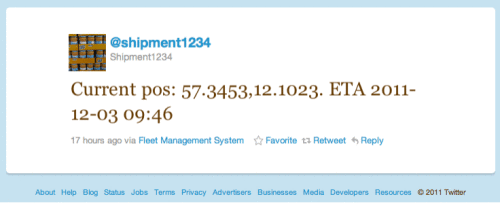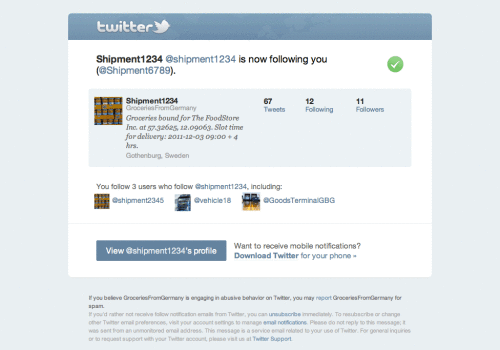Social shipments – What if a pallet had a Twitter account?
Is it possible to build an information sharing network for transport based on what is already online? A system that is robust, flexible, cheap and modern? Maybe. But you have to think a little outside the box…
Are you on Facebook? Twitter? LinkedIn? Google +?
Many of you have, I suspect, accounts on more than one of these networks. As individuals, we use the Internet to communicate, exchange information, views and experiences, or perhaps market ourselves or a service or product. We have a digital infrastructure that we (some of us anyway) see as an extension of our persona from the analog to the digital reality. It is just as ”real” to meet and exchange information online as via a physical meeting. The channel is different, the communication process as well. Still, it is just as real.
Looking at information management related to transportation, we also see a digitization trend. Of course. As I have previously written, this becomes a critical issue for the transportation industry when it comes to ”upgrading” to the next level, which is not possible by refining and improving existing, physical, systems. You simply have to think differently. What can we learn from the information technology development? Can this be applied to transportation? How?
Many questions.
So let us do a little thought experiment. Do you know Twitter? Well, a short description might be in order anyway.
Twitter is a communication channel where people can post short messages (140 characters maximum). These messages are called tweets and can be read by anyone. If you want to build your own flow of messages from different people, you can choose to follow them. This means that people choose to subscribe to the twitter posts from the ones they want to follow. If someone chooses to follow me, I get a message about this and can – if I want – follow this person in return. His tweets end up in my feed along with all the others that I already follow. There are more features and nuances, but this is the essence of Twitter.
Now let us assume that we would like to use Twitter in a different way. Imagine that each shipment in a transportation system has a twitter account. Every vehicle, transshipment terminal, every carrier as well. Let’s say ”we” are a consignment containing German food called Shipment6789. We have a twitter account with the same name. We are heading to a grocery store in Sweden and all of a sudden we get a new companion (click on image for larger version):
This means that anyone interested can now see that both of these shipments actually are transported together. The picture above also shows that we both follow Shipment2345, Vehicle18 and GoodsTerminalGBG.
We actually just built a scalable, flexible, robust, inexpensive and transparent transport information management solution. Sure, the concept can be developed further, but the basics are there. Another example:

Shipment1234 reports location and estimated time of arrival. Anyone interested in following the account is kept up to date.
By posting status reports when something happens (or when some condition is met, such as a time interval since the last posting), those who wish to follow the consignment can do so. An IT system at the recipient may use this information to ensure that staff are in place at the estimated arrival time. Or why not let an environmental accounting system to keep track of all messages associated with a given vehicle to thereby subsequently be able to calculate the environmental impact?
When state changes are sent, of course, messages like:
As soon as another user is mentioned in a tweet, this becomes a hyperlink (to write @ in front of the name, for example, @drlogistics). Clicking on Vehicle18 in the tweet above links to the vehicle’s own page where all its postings are listed in chronological order.
What can you learn from this exercise? Many things, of course, but the important thing is perhaps an understanding that the infrastructure and logic built into the social networks online is universal and could be used for completely different applications. It’s all about thinking a little outside the box.
A little exercise for those of you who have read all this way down could be to illustrate a transportation system using Facebook instead. What would be the consequences? Is it even possible? Desirable? Please comment below!
0



